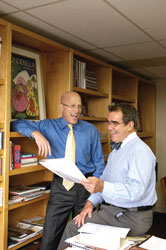It is clear that the new administrative and rehearsal facility that opened recently above the W. L. Lyons Brown Theatre on Broadway represents something greater than a mere change of address for a couple of arts groups. It might be characterized as a sea change in the way performing-arts organizations do business in a hostile environment, where costs rise and audiences diminish in numbers and increase in age.
The prime mover in creating the new layout, collectively and aptly named Artspace, is Allan Cowen, now in his 30th year running one of the nation’s most successful community arts funds. The Fund for the Arts supports 24 local arts entities as member groups and makes grants to 200 community organizations and schools as it miraculously bucks the international tr/files/storyimages/of declining arts support by each year ratcheting up its goal: This year it aimed for $8 million and reports coming in at slightly over that figure.
The Fund has underwritten the $7 million Artspace project and Cowen has been his own very hands-on project manager, controlling every aspect of the 700,000-square-foot renovation in space that is now Fund property. Brad Broecker and David Roth, who head, respectively, the Louisville Orchestra and Kentucky Opera, are enthusiastic participants because they see a chance to operate out of cheaper, more efficient spaces. They also predict major creative cooperation from their newfound proximity. Both note the added convenience of a 4,000-square-foot rehearsal space attached to the Brown Theatre and the possibility of using the recently upgraded venue for more of their smaller-scale performances.
Heading the new Artspace is Fund for the Arts president and CEO Allan Cowen.
The idea of Artspace is at least 12 years old. Talk of an administrative warehouse serving and served by the Brown Theatre dates at least to the last major renovation of the space in 1998. Then, a number of major donors assisted in bringing the former Macaulay Theatre to new life — among them Jane and Charles Boyer, who donated a new stage and machinery system; and the Owsley Brown family, their company and foundation, whose members variously contributed in a number of backstage and front-of-the-house areas.
If Artspace is such a good idea, why did it take so long? The defining action was the donation by Bill Receveur and his partners of eight floors of the 10-story Brown office building, located at 321 W. Broadway. The office space, located above and around the theater, was given to the project, Receveur says, to promote a synergy among arts groups that would yield citywide benefits. The gift is valued at $2.5 million. In addition, creating the new rehearsal space was funded with a $125,000 gift from the W. L. Lyons Brown Foundation. Building new pedways between
There are also some spectacularly frugal aspects to the renovation. The carpets are recycled from the lobby of Whitney Hall at the
Cowen claims he always intended that the Fund for the Arts would one day own the Brown office building and he moved fast once the gift of the eight floors was made. The renovation was completed in 90 days and now serves three grades of tenants. The not-for-profit groups pay a much-subsidized rent; others, like the
Roth (left) and Broecker also laud the Brown’s rehearsal and performance spaces.
The top two floors of the building are expected to hold upscale condominiums. Cowen is excited about the “dynamic mix,” as the lobby and elevators can be expected to service a cross-section of artists, administrative staff, students, technicians, businesspersons and residents. Says Cowen: “Artspace creates a dynamic intersection of arts interests (and) educational and community groups that extends the value of the community’s investment in the Fund for the Arts — not just onstage but offstage — and assures that we bring the same excellence to the business of the arts and the arts business.” 
What this high language really means is that Cowen would like to see more arts groups move into Artspace for business reasons. Stage One and Music Theatre Louisville are already there. (The Louisville Ballet has its own special needs and custom-designed premises on
Long-term, the value of the project will be judged by how successfully it functions on three levels. First, will it save money for the arts groups? Broecker and Roth say that is already happening. The move from their separate
Broecker is keen that we see the Brown not as a place of refuge when Phantom of the Opera pushes resident groups out of the Whitney, but as a truly viable performing space in its own right. Roth adds that the scale and economics of the Brown Theatre make it possible to be more adventuresome in choices of repertory. Kentucky Opera is still in the planning stage of returning to the Brown for main-stage productions (though Roth is known to be looking at late 2008 for some product there). Meanwhile, the Louisville Orchestra will give approximately 30 concerts in the Brown in the 2007-08 season: 20 or so in the Making Music and
Controversy has raged for years over the suitability of the Brown as an alternative performing space to the larger Whitney. Those in favor quote its brighter, clear acoustics and ideal “European” size. David Roth is more blunt: “If you are only going to sell 1,000 tickets for an event, it will look like a full house in the Brown,” he says. “The same number will look sparse in the Whitney.”
It is also much cheaper to present at the Brown Theatre. The rent is lower, smaller stage crews mean lower labor costs, and the smaller pit suits a smaller orchestra. Those opposed often cite its inaccessibility from safe parking (recently mitigated by pedways connecting the hall with parking), poor access to upper floors (three elevators now serve the balcony) and cramped seating (ameliorated by re-spacing in many rows). However, professionals are still underwhelmed by its cramped backstage.
Touring blockbusters like The Lion King mean that the Whitney is off-limits to the resident groups for many of the best weeks of the year, but only a curmudgeon would deny that such spectaculars are a boon to the
An undercurrent in all talk of Artspace is that there is a new climate of friendship and cooperation among arts groups as they struggle to attract audiences and stay financially viable in a shrinking market. Cowen is blunt in saying that arts leadership both at board and staff levels went through some challenging times in the ’90s and early 2000s, but a spirit of cooperation is changing the landscape. He predicts a day when Kentucky Opera and the Louisville Orchestra will have one general manager and one administrative and production staff while retaining separate artistic identities.
Artspace is the most recent manifestation of this new dawn. If more performing-arts groups are coaxed into tenantship in the new “arts laboratory,” a brighter future may emerge. And, the thinking goes, a more cost-effective one.
Contributor Thomson Smillie may be reached at editorial@loumag.com.


